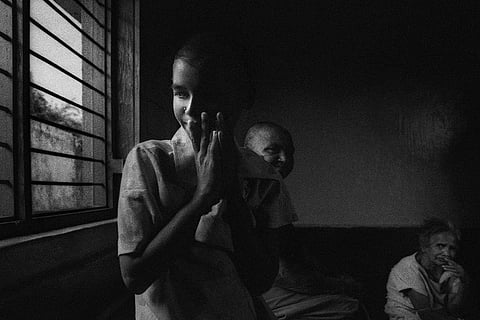
- News
- Campus
- Exam
- Podcast
- Web Stories
- Do You Know
- Path Finders - UG Programs
- Videos
- Élitscape

One of the most prestigious events to feature on Hyderabad's calendar is the Indian Photography Festival. This not-for-profit initiative by Light Craft Foundation is helmed by Aquin Mathews. For a few days, the City of Nizams plays host to the most reputed photographers of India and the world. And not only is their work displayed, but you also get to learn the tricks of the trade from them through artist talks and workshops. This time, the festival saw stalwarts from the field like Vietnamese-American photographer Nick Ut, who shot the iconic 1972 photograph of a young girl running away from the smoke of a napalm attack in Vietnam, Tasneem Alsultan from the Middle East, who famously covered the first women's voting and elections in Saudi Arabia, and our very own Mahesh Shantaram, who's compelling photo series The African Portraits is still fresh in our minds. If you think you have missed out, fret not, their work is still on display at State Art Gallery Madhapur; Goethe-Zentrum Hyderabad, IIT Hyderabad and various other locations and will be there till October 7. Meanwhile, amongst the hustle and bustle of the festival, we, fortunately, were able to catch up with two photographers whom we were excited about.
Robin Schwartz
When Amelia Paul was born to New Jersey-based photographer Robin Schwartz, she was premature. Of course, it was scary. Amelia was all tubed up and her lungs were not developed. Nursing her helped strengthen the mother-daughter bond. Another initiative that aided the growth of the relationship was the project, Amelia and the Animals. Schwartz, who holds a special place in her heart for animals and those who help them, says, "They are my tribe. They resonate in my heart, being around them makes me happy." So her project, which started in 2012, was to photograph her beloved daughter with various animals. (The one with Amelia feeding a tiger cub with a bottle of milk is our favourite!) "Amelia and I continue to work together on Swan Song, the last portion of the Amelia and the Animals photographs which also includes fashion," she informs us.
Speaking about mobile phone photography, the Associate Professor in Photography at William Paterson University, New Jersey says, "As of September, I am a full-time Professor of photography!" she happily corrects us and adds, "Cellphone photography is great, anything that gets my students to work and look at photos, read captions, look at the news. Instagram can also provide education to photography in its many applications." Currently, she is photographing caretakers and those they rescue for her Guggenheim Fellowship project.
Prabhakar Kusuma
2018 has been a fantastic year for Prabhakar Kusuma. The fact that he was declared a Fellow of The Royal Photographic Society (FRPS), Great Britain for his wonderful series The Destitute, which he shot while visiting a destitute home in his hometown Warangal in 1993, makes us proud of this photographer. "I did not do it with the FRPS in my mind, but did it to express myself, the emotions the destitute were experiencing and the feelings that had invoked in me," says Kusuma who moved to Hyderabad in 1995.
One look at Kusuma's photographs from The Destitute series and you'll probably understand what an emotional journey it must have been for him to click them. We ask him how he lets the subject's emotions flow without his influence hampering it and he tells us the simplest way — by giving the photographer's vest and hat a miss, using small cameras and lenses and refraining from using shiny chrome-coated camera bodies and chrome-coated lenses while on these assignments. Further, he explains that, "visual elements like line, tone, colour, form, the play of light, background and the composition should be used shrewdly to convey the emotions of the subject. Fear and sorrow are associated with black not without a reason. It is derived from our own subconscious fear of the dark and the sorrow we feel when we are put in the dark, which make us feel the same fear and sorrow when we see a weeping child against a black background."
Going into more details he says, "When I enter a situation, I take the light reading and set it on the camera, focus on what I am interested in and let the camera wait. I don't sit or stand before my subject. I am at a right angle to the subject, giving them the impression that I am not interested in them. I watch them with a slight tilt of my head and wait. When I anticipate that the next emotion they show will be perfect, without changing my position, I turn, lift the camera to my eye, see and release the shutter. If I've seen the peak of their action or emotion, it means that I've lost the picture."
Despite the field and the people in the field not always being kind to Kusuma, he still sees them as his greatest well-wishers. "Tibetan Buddhism says that we have to treat our rivals and those jealous of our success as precious diamonds and ornaments, for they are the people who constantly goad us and push us to the edge with their words and deeds. They never allow us to stop and breathe, making us work harder," he concludes.
For more on it, click on indianphotofest.com
